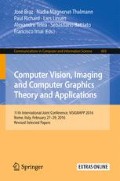Abstract
The problem of grasping unknown objects utilising vision is addressed in this work by introducing a novel feature, the Sliced Pineapple Grid Feature (SPGF). The SPGF encode semi-local surfaces and allows for distinguishing structures such as “walls”, “edges” and “rims”. These structures are shown to be important when learning successful grasping affordance predictions. The SPGF feature is used in combination with two different grasp affordance learning methods and achieve grasp success-rates of up to 87% for a combined varied object set. For specific object classes within the object set, success-rates of up to 96% is achieved. The results also show how two different grasp types can complement each other and allow grasping of objects that are not graspable by one of the types.
Access this chapter
Tax calculation will be finalised at checkout
Purchases are for personal use only
References
Krüger, N., Janssen, P., Kalkan, S., Lappe, M., Leonardis, A., Piater, J., Rodríguez-Sánchez, A.J., Wiskott, L.: Deep hierarchies in the primate visual cortex: what can we learn for computer vision? IEEE PAMI 35, 1847–1871 (2013)
Lloyd, S.: Least squares quantization in PCM. IEEE Trans. Inf. Theor. 28, 129–137 (2006)
Thomsen, M., Kraft, D., Krüger, N.: Identifying relevant feature-action associations for grasping unmodelled objects. Paladyn J. Behav. Robot. 6(1), 85–110 (2015)
Curtis, N., Xiao, J., Member, S.: Efficient and effective grasping of novel objects through learning and adapting a knowledge base. In: IEEE International Conference on Robotics and Automation (ICRA), pp. 2252–2257 (2008)
Huebner, K., Ruthotto, S., Kragic, D.: Minimum volume bounding box decomposition for shape approximation in robot grasping. In: IEEE International Conference on Robotics and Automation, ICRA 2008, pp. 1628–1633. IEEE (2008)
Detry, R., Ek, C.H., Madry, M., Kragic, D.: Learning a dictionary of prototypical grasp-predicting parts from grasping experience. In: IEEE International Conference on Robotics and Automation (2013)
Kopicki, M., Detry, R., Schmidt, F., Borst, C., Stolkin, R., Wyatt, J.L.: Learning dexterous grasps that generalise to novel objects by combining hand and contact models. In: IEEE International Conference on Robotics and Automation (2014, to appear)
Saxena, A., Driemeyer, J., Ng, A.Y.: Robotic grasping of novel objects using vision. Int. J. Robot. Res. 27, 157–173 (2008)
Kootstra, G., Popović, M., Jørgensen, J.A., Kuklinski, K., Miatliuk, K., Kragic, D., Krüger, N.: Enabling grasping of unknown objects through a synergistic use of edge and surface information. Int. J. Robot. Res. 31(10), 1190–1213 (2012)
Lenz, I., Lee, H., Saxena, A.: Deep learning for detecting robotic grasps. CoRR (2013)
Jiang, Y., Moseson, S., Saxena, A.: Efficient grasping from RGBD images: learning using a new rectangle representation. In: ICRA 2011, pp. 3304–3311 (2011)
Redmon, J., Angelova, A.: Real-time grasp detection using convolutional neural networks. CoRR abs/1412.3128 (2014)
Krizhevsky, A., Sutskever, I., Hinton, G.E.: Imagenet classification with deep convolutional neural networks. In: Advances in Neural Information Processing Systems, pp. 1097–1105 (2012)
Myers, A., Teo, C.L., Fermüller, C., Aloimonos, Y.: Affordance detection of tool parts from geometric features. In: ICRA (2015)
Bohg, J., Morales, A., Asfour, T., Kragic, D.: Data-driven grasp synthesis a survey. IEEE Trans. Robot. 30, 289–309 (2014)
Durrant-Whyte, H., Bailey, T.: Simultaneous localization and mapping: part i. IEEE Robot. Autom. Mag. 13, 99–110 (2006)
Kraft, D., Mustafa, W., Popovic, M., Jessen, J.B., Buch, A.G., Savarimuthu, T.R., Pugeault, N., Krüger, N.: Using surfaces and surface relations in an early cognitive vision system. In: Computer Vision and Image Understanding (2014)
Wahl, E., Hillenbrand, U., Hirzinger, G.: Surflet-pair-relation histograms: a statistical 3D-shape representation for rapid classification. In: Proceedings of Fourth International Conference on 3-D Digital Imaging and Modeling, 3DIM 2003, pp. 474–481. IEEE (2003)
Mustafa, W., Pugeault, N., Krüger, N.: Multi-view object recognition using view-point invariant shape relations and appearance information. In: IEEE International Conference on Robotics and Automation (ICRA) (2013)
Freedman, D.A.: Statistical Models: Theory and Practice. Cambridge University Press, Cambridge (2009)
Jørgensen, J.A., Ellekilde, L.P., Petersen, H.G.: RobWorkSim - an open simulator for sensor based grasping. In: Robotics (ISR), 2010 41st International Symposium on and 2010 6th German Conference on Robotics (ROBOTIK), pp. 1–8 (2010)
Kasper, A., Xue, Z., Dillmann, R.: The KIT object models database: an object model database for object recognition, localization and manipulation in service robotics. Int. J. Robot. Res. 31(8), 927–934 (2012)
Archive3D: Archive3D free online cad model database. http://www.archive3d.net
Acknowledgement
The research leading to these results has received funding from the European Community’s Seventh Framework Programme FP7/2007-2013 (Specific Programme Cooperation, Theme 3, Information and Communication Technologies) under grant agreement no. 270273, Xperience.
Author information
Authors and Affiliations
Corresponding author
Editor information
Editors and Affiliations
Rights and permissions
Copyright information
© 2017 Springer International Publishing AG
About this paper
Cite this paper
Thomsen, M.T., Kraft, D., Krüger, N. (2017). The Sliced Pineapple Grid Feature for Predicting Grasping Affordances. In: Braz, J., et al. Computer Vision, Imaging and Computer Graphics Theory and Applications. VISIGRAPP 2016. Communications in Computer and Information Science, vol 693. Springer, Cham. https://doi.org/10.1007/978-3-319-64870-5_20
Download citation
DOI: https://doi.org/10.1007/978-3-319-64870-5_20
Published:
Publisher Name: Springer, Cham
Print ISBN: 978-3-319-64869-9
Online ISBN: 978-3-319-64870-5
eBook Packages: Computer ScienceComputer Science (R0)

